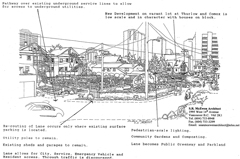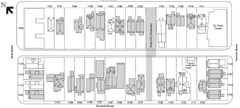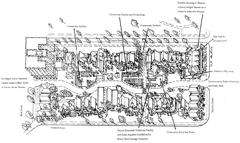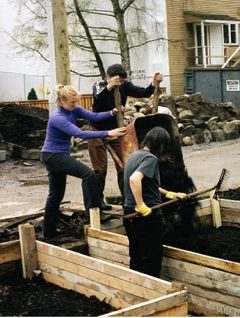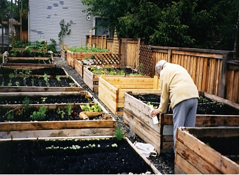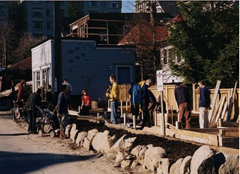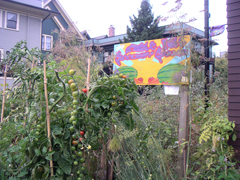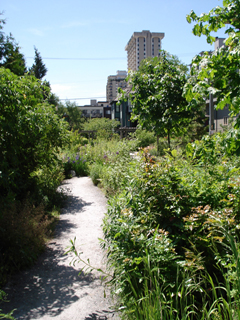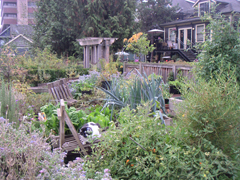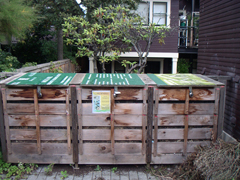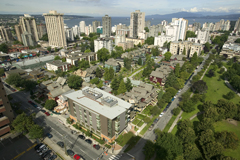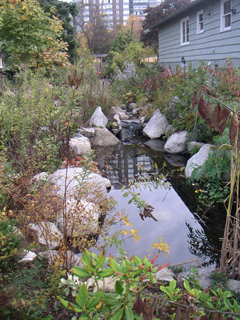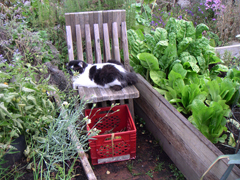Mole Hill
Exhibit Category / Catégorie de l'expo: Housing
Location/Emplacement: Vancouver, BC, Canada
Dates: 1999 - present
Designers/Concepteurs: Dialog; Sean R. McEwen Associated Architects; Landscape: Durante Kreuk, Sean R. McEwen Associated Architects
Clients: The City Of Vancouver, BC Housing & Mole Hill Community Housing Society
More Information/Plus d'informations: Mole Hill
Image Credits/Crédits d'images: Margot Beauchamp, DIALOG, Joe Nasr
Project Description: (version française ci-dessous)
The Mole Hill Community Housing Project, located around a laneway between Comox, Pendrell, Bute and Thurlow streets in downtown Vancouver was completed in 2003. The project is noteworthy not only for the retention and restoration of 26 heritage buildings, creation of 170 units of affordable housing, and a child-care precinct, but it also incorporates significant sustainable design features. The pedestrian-priority open space design features a greenway in the lane behind the houses, planted entirely with food plants. This “living lane” provides a pedestrian friendly space for the surrounding community to gather.
The lane also features community garden plots, and a community-oriented laundry room, workshop, refuse and recycling area. An innovative geothermal heating system in each building is sourced from one ground loop and a well planned storm water management system retained 95% of pre-existing trees and diverts rainwater into an ornamental pond rather than into the city’s storm system. Mole Hill is a model of exemplary planning that encourages sustainability through the use of communal living to minimize consumption
Browse for more projects in the Carrot City Index.
Description du Projet:
Le projet de logements communautaires de Mole Hill à Vancouver est remarquable à différents égards : non seulement il restaure 26 édifices patrimoniaux et crée 170 logements abordables et d’une crèche, mais sa conception respecte aussi les principes du développement durable. Mole Hill intègre de façon harmonieuse la production alimentaire à la transformation de terrains privés en espaces verts communs.
Cet ensemble de bâtiments, datant de la fin l’époque victorienne, a été presque entièrement démoli lorsque la ville de Vancouver a entrepris dans les années 1950 de libérer de l’espace en supprimant un grand nombre de constructions. Des organismes de défense du patrimoine se sont vivement opposés à la démolition de ces édifices patrimoniaux. La municipalité a finalement accepté de les conserver et d’investir dans le projet, en louant le terrain et les maisons à la Community Housing Society (Société de logement communautaire) pour une durée de 60 ans. La transformation a débuté en 1999 par une rénovation écologique du site visant à créer un environnement résidentiel diversifié, abordable et socialement responsable qui valorise l’ensemble du quartier de West End.
L’espace donne la priorité aux piétons. Une voie verte située dans la ruelle derrière les maisons constitue un « chemin vivant » où les habitants du quartier se rassemblent. La ruelle comprend également des parcelles de jardins partagés, une buanderie, un atelier et un espace de mise au rebut et de recyclage ouverts à tous. Dans chaque bâtiment, un système innovant de chauffage géothermique est alimenté par un circuit souterrain ; de plus, une installation de récupération des eaux de pluie entretient 95% des arbres et redirige l’eau vers un bassin d’ornement plutôt que vers le système d’évacuation des eaux pluviales de la ville. Par sa promotion d’une vie collective qui réduit la consommation, la conception de Mole Hill est exemplaire en matière de développement durable.
Trouvez d’autres projets avec l’Index de Carrot City.


